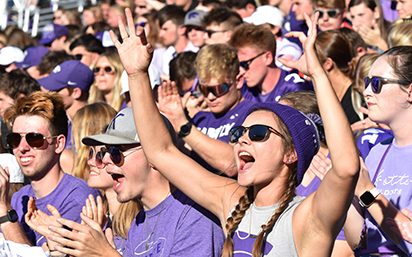
University shares update on student enrollment
Despite a challenging year caused by the ongoing pandemic, Kansas State University
has recorded its highest graduation rate in recent history — a rate that is higher
than the national average. Although overall enrollment is down 3% this fall at K-State,
recruitment of new freshmen and transfers has stabilized following several years of
smaller classes.
Total student enrollment is 20,229 for fall 2021 and includes increases in transfer
students, at K-State Salina, graduate students and new international freshmen and
international graduate students. New student enrollment — including new freshmen and
transfer students — dipped only 1% from last year.
K-State continues to lead all Regents institutions in key student success indicators:
the student retention rate of 86% is tied for highest, while K-State's six-year graduation
rate of 68.4% is the best and well above the 63.9% national average for four-year
doctoral institutions. Larger graduating classes have led to an overall decrease in
enrollment as smaller incoming classes in previous years work through the system.













 Doug originally decided to attend K-State because Tiffany decided to attend K-State
— but their story doesn’t actually begin there. The couple first met in seventh grade
and started dating their junior year of high school.
Doug originally decided to attend K-State because Tiffany decided to attend K-State
— but their story doesn’t actually begin there. The couple first met in seventh grade
and started dating their junior year of high school. Doug had many highlights as part of his military career, including his first duty
station in Germany when he and Tiffany were newlyweds fresh out of college. Doug loved
the National Training Center at Fort Irwin in California, which looked just like a
Hollywood movie set where soldiers could run drills as they prepared to deploy to
Iraq. He enjoyed being stationed in Fort Riley, close to his alma mater, and he later
served as a general’s aide to the U.S. military representative within NATO, living
in Brussels, Belgium.
Doug had many highlights as part of his military career, including his first duty
station in Germany when he and Tiffany were newlyweds fresh out of college. Doug loved
the National Training Center at Fort Irwin in California, which looked just like a
Hollywood movie set where soldiers could run drills as they prepared to deploy to
Iraq. He enjoyed being stationed in Fort Riley, close to his alma mater, and he later
served as a general’s aide to the U.S. military representative within NATO, living
in Brussels, Belgium. Currently there is no cure for mesothelioma, which according to Mayo Clinic is a type
of cancer that occurs in the thin layer of tissue that covers the majority of the
internal organs. Only about 3,000 people are diagnosed with mesothelioma each year
in the United States, and it is rare for someone as young as Doug to be diagnosed.
Currently there is no cure for mesothelioma, which according to Mayo Clinic is a type
of cancer that occurs in the thin layer of tissue that covers the majority of the
internal organs. Only about 3,000 people are diagnosed with mesothelioma each year
in the United States, and it is rare for someone as young as Doug to be diagnosed. Doug and Tiffany’s daughter Mackenzie is now a first-year student at Notre Dame, and
their son Brenden is starting high school. The Thomases recently moved to the Kansas
City area to be closer to family, and Tiffany continues to receive emails from people
who knew Doug or worked with him.
Doug and Tiffany’s daughter Mackenzie is now a first-year student at Notre Dame, and
their son Brenden is starting high school. The Thomases recently moved to the Kansas
City area to be closer to family, and Tiffany continues to receive emails from people
who knew Doug or worked with him.
 In this new memoir, Snyder reflects on a successful yet complicated life, detailing
the grueling 80-hour work weeks, his visionary Wildcat Goals for Success, and the
virtues he doubled down on during his final years as head coach, all the while battling
throat cancer. Readers will discover a multi-faceted portrait of one of college football's
greatest leaders, his triumphs and defeats, his greatness and his flaws, and his passion
and drive to, not once, but twice, lead a championship team while developing young
men.
In this new memoir, Snyder reflects on a successful yet complicated life, detailing
the grueling 80-hour work weeks, his visionary Wildcat Goals for Success, and the
virtues he doubled down on during his final years as head coach, all the while battling
throat cancer. Readers will discover a multi-faceted portrait of one of college football's
greatest leaders, his triumphs and defeats, his greatness and his flaws, and his passion
and drive to, not once, but twice, lead a championship team while developing young
men.



 Scheetz credits her professors at K-State for supporting her interests and developing
her clinical skills in a way that made her confident enough to start her own speech-language
pathology program in a community immediately following graduation.
Scheetz credits her professors at K-State for supporting her interests and developing
her clinical skills in a way that made her confident enough to start her own speech-language
pathology program in a community immediately following graduation. Although working in health care during the COVID-19 pandemic brought added challenges
for both Scheetz and her patients, she never stopped meeting needs in the community
she served.
Although working in health care during the COVID-19 pandemic brought added challenges
for both Scheetz and her patients, she never stopped meeting needs in the community
she served. 
